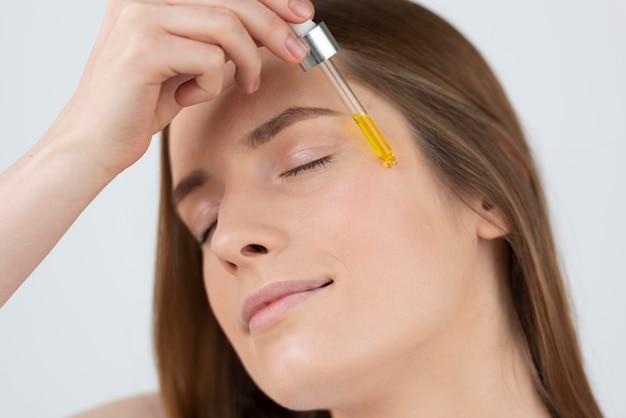When it comes to achieving a flawless complexion, hyperpigmentation can be a persistent obstacle. These dark spots or uneven skin tone are often the aftermath of acne, sun damage, or hormonal changes. Among the various treatments available, niacinamide, a form of vitamin B3, has become a standout solution. Scientific research suggests that niacinamide can significantly alleviate hyperpigmentation, revealing a more even skin tone. This article will delve into the properties of niacinamide and how it may be your ally in fading those stubborn spots.
Understanding Hyperpigmentation: More Than Just a Surface-Level Issue

Hyperpigmentation manifests as areas of skin that become darker than the surrounding tissue. This discoloration is typically the result of excess melanin production, influenced by factors such as ultraviolet (UV) exposure, inflammation, and hormonal imbalances. There are various forms of hyperpigmentation, including age spots, melasma, and post-inflammatory hyperpigmentation (PIH), each presenting its own challenges.
Melanin is the pigment responsible for determining skin color, and overproduction in certain areas leads to the visible dark spots so many strive to lighten. The condition not only affects the surface appearance but can also have profound psychological impacts, affecting one’s self-esteem and quality of life.
Niacinamide – A Skincare Marvel for Pigmentation Problems

Niacinamide is renowned in skincare for its multi-faceted benefits. This powerhouse ingredient is applauded for its ability to support the skin’s barrier function, regulate oil production, and diminish the appearance of fine lines. However, its prowess in treating hyperpigmentation is of particular interest.
At a cellular level, niacinamide impedes melanin from reaching the skin’s surface and dispersing. By inhibiting the transfer process, niacinamide gradually lightens pigmented areas. It also offers anti-inflammatory properties that can prevent new discolorations from forming.
Scientific Insights: The Efficacy of Niacinamide on Hyperpigmentation
A wave of clinical studies backs the positive impact of niacinamide on hyperpigmentation. Research has consistently shown that topical application can lead to a visible reduction in dark spots. One noteworthy study revealed that, over time, participants using niacinamide noted a significant decrease in the severity of their pigmentation issues compared to those who did not.
Evidence supporting niacinamide’s effectiveness adds to the enthusiasm around this ingredient. Dermatologists often recommend it as part of a comprehensive skincare routine targeting hyperpigmentation.
Incorporating Niacinamide into Your Skincare Routine
Adopting niacinamide into your skincare regimen can be seamless, as it’s included in a variety of products such as serums, moisturizers, and toners. The optimal concentration of niacinamide for addressing hyperpigmentation ranges from 2% to 5%.
For maximum effectiveness, niacinamide-infused products should be applied to clean skin, followed by moisturizer and sunscreen during the day. Here’s a simple numbered list to guide you through:
- Cleanse your skin to remove impurities.
- Apply a niacinamide serum or treatment to the affected areas.
- Layer with a moisturizer to lock in hydration.
- Finish with a broad-spectrum sunscreen in the daytime.
Complementary Treatments: Enhancing the Effects of Niacinamide
While niacinamide can be influential on its own, pairing it with other skincare ingredients can amplify its pigmentation-fighting capabilities. Vitamins C and E, retinol, and alpha hydroxy acids (AHAs) are often recommended as compatible companions. Combining these with niacinamide can lead to improved texture and accelerated results.
Second numbered list with recommended ingredient pairings:
- Vitamin C: For antioxidant protection and brightening.
- Retinol: For promoting cell turnover and collagen production.
- AHAs: For gentle exfoliation to remove pigmented cells.
Real Results: Dispelling Myths and Confirming Facts
As with any popular skincare trend, niacinamide comes with its share of myths. One common misunderstanding is that niacinamide can irritate the skin, causing redness and peeling similar to retinol or AHAs. In reality, niacinamide is known for its gentle nature and is often used to soothe irritated skin.
Countless users have shared their success stories, providing anecdotal evidence that supports scientific findings. Before-and-after photos often depict significant improvement in skin clarity and hyperpigmentation reduction after consistent use of niacinamide products.
Daily Dosage: How Much Niacinamide is Too Much?
While niacinamide is typically safe for daily use, exceeding recommended concentrations can lead to skin irritation in some individuals. Symptoms of overuse might include itching, redness, or a burning sensation. As a rule of thumb, stick to formulations with recommended niacinamide percentages and monitor your skin’s reaction.
In the event of excessive use, here is an approach to stabilization:
| Signs of Overuse | Steps for Mitigation |
|---|---|
| Redness & Irritation | Reduce frequency of application |
| Itching or Burning | Discontinue use and consult a dermatologist |
| Flaking or Peeling Skin | Hydrate the skin with emollients |
Patience and Persistence: Understanding the Timeline for Improvement
Transforming hyperpigmentation with niacinamide is not an overnight process. Improvements in skin tone may start to be noticeable after a few weeks, with full effects often taking several months. Consistency is crucial, and patience will be rewarded with gradual brightening and an overall more even complexion.
It is important to maintain a steady regimen and not to give up too early; otherwise, progress may plateau, and benefits may take longer to manifest.
Conclusion: Embracing Niacinamide for Brighter, More Even-Toned Skin
In conclusion, niacinamide holds promise for those struggling with hyperpigmentation. Its skin-brightening and anti-inflammatory properties make it an integral part of a skincare routine aimed at achieving a more uniform complexion. By following the usage guidelines and pairing niacinamide with complementary ingredients, individuals may witness a significant reduction in the appearance of their dark spots, along with other fortifying benefits for overall skin health.
FAQs
- Q1: How long does it usually take to see results from niacinamide for hyperpigmentation?
- A1: Results vary, but many users report noticing improvements within 4 to 12 weeks of consistent use.
- Q2: Can niacinamide be used in conjunction with other active ingredients to treat hyperpigmentation?
- A2: Yes, when used correctly, niacinamide can be combined with other ingredients like vitamin C, retinoids, and AHAs for enhanced results.
- Q3: Is niacinamide safe for all skin types, including sensitive skin?
- A3: Niacinamide is well-tolerated by most skin types, but individuals with sensitive skin should start with lower concentrations and patch test new products.
- Q4: Can niacinamide cause skin purging?
- A4: Niacinamide is not typically associated with skin purging as it does not prompt an increased rate of cell turnover.
- Q5: Do I need to wear sunscreen when using niacinamide products?
- A5: Wearing sunscreen is essential for protecting the skin from further UV-induced pigmentation, regardless of whether niacinamide is part of your routine.

